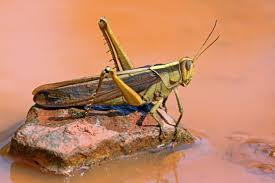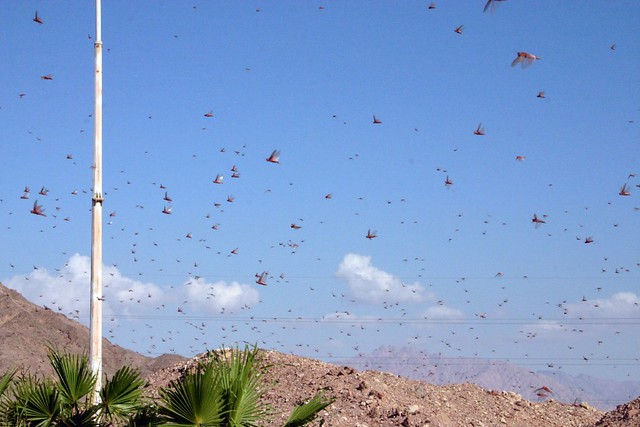Locusts are termed as the oldest migratory pests in the world. They are short-horned grasshoppers, belonging to a family called Acrididae. They have the ability to change their behaviour with respect to changes in weather and region. These locusts form swarms of adults (bands of hoppers) and breed on standing crops and plants.
Recently, Locust Swarm has made the headlines with its early arrival in India, affecting five states at the moment – Maharashtra, Rajasthan, Punjab, Haryana and Madhya Pradesh. In 2020, the locust swarm is termed the ‘worst in 26 years,’ and the United Nations (UN) has warned it to be posing a ‘severe risk’ to India’s agriculture this year.
The topic, ‘Locust Swarm’ is seen as important from the IAS Exam perspective as it forms an important topic for the Current Affairs section and also Geography subject. Read this article to learn important facts about Locusts, Desert Locusts and the challenges associated with these.


Facts about Locusts – Locust Swarms for UPSC
The table below mentions a few important facts about Locusts that can be important for UPSC 2023:
| Locust Swarms – Facts for UPSC |
There are ten prominent species of Locusts:
|
In India, out of these ten locusts, only four are reported:
|
Scientific Names of the locusts reported in India are:
|
| Desert Locus is the most harmful for the plants and standing crops and pose a great threat to Indian Agriculture. They have their origin from Saudi Arabia |
| The Locusts who are in their nymphal stage and yet to reach adulthood are called Wingless Nymphs and in a group, they are called bands of locusts |
| Locust Swarms are highly mobile and they can be very dense. One swarm of locust can have around 80 lakhs of these |
| Locusts and Grasshoppers are not the same. Locusts form a part of Grasshoppers but differ in their movement and behavioural patterns |
| Locusts belong to the family called Acrididae |
Desert Locusts are polyphagous feeders – They have the ability to feed on many kinds of food:
|
| Desert Locusts can also break down trees when they settle on these in masses. The weight of such masses of locusts is such that a tree can fall down |
| In the world, around 64 countries are mostly affected by locust swarms |
| Desert Locusts fly at a speed of 16-19 km/hour; however, the speed also depends on the wind speed |
| Locust Swarms can cover 5-130 km of distance in a day and can stay in the air for a long period of time |
| When a solitary locust flies, it usually flies at night; however when it is part of locust swarms; they fly during the day |
| Widespread rainfall generates an increase in the numbers of Locusts and the Food and Agricultural Organisation (FAO) has warned that locust numbers could grow another 20 times during the upcoming rainy season unless control activities are stepped up |
| The lifespan of a locus is 90 days |
| The swarm of locusts always stay together and eat the food of their size each day |
| They can populate easily in three breeding seasons by 16000 times |
Also Read | Daily News Analysis for UPSC Preparation.
Locust Swarms & India
The following points mention the state of India amid current locust swarms attack:
- Desert Locusts have followed the wind patterns to cover a vast stretch from the Rab’ al-Khali desert of Saudi Arabia to the fields of Rajasthan and beyond.
- These desert locust swarms have destroyed crops in agricultural fields of states of Rajasthan, Gujarat, Maharashtra, Madhya Pradesh, Punjab and also Uttar Pradesh.
- With the onset of monsoon and change in wind direction, they fly towards India from Saudi Arabia, crossing the Red Sea over to Iran and Pakistan.
- India faces an average of 10 locus attacks in a year.
- 2020 had also seen extensive rain in India before the expected months following which moisture and greenery have attracted locusts. Egg-laying also occurs in the rainy season
- According to FAO, a single square kilometre of the locust swarms can contain up to 80 million adults and can eat as much food as 35,000 people in terms of weight in a single day.
- Longer-than-usual monsoon across the Indo-Pakistan border and frequent cyclones in the Indian Ocean are speculated to be the reasons for the early locust swarm attack.
Check | Current Affairs for UPSC
Indian Cities/districts that are affected by the outbreak of locusts swarms are:
| Nagaur | Jaipur | Dausa | Bangra Magarpur |
| Western Rajasthan districts | Malhargarh | Jhansi | Amravati |
| Wardha | Nagpur | Delhi has been put on alert |
India’s Response to Locust Swarms
Locust Watch Centres are warning farmers of the speculated movement of the locust swarms. Also, the use of organophosphate chemicals with ultra-Low volume sprayers is a method to control the locust swarms attack. ‘Chlorpyriphos’ is being reserved in certain cities as it is effective in controlling a variety of insects following ministries are keeping the charge of the locust attacks:
- Ministry of Agriculture and Farmers Welfare, Department of Agriculture, Cooperation and Farmers Welfare
- Ministry of External Affairs
- Ministry of Home Affairs
- Ministry of Defence
- Ministry of Earth Sciences
- Ministry of Civil Aviation and
- Ministry of Communications
The role of stakeholders like State Governments, State Health Department and farmers, is equally important. The government is making use of drones to track the locust swarms movements. The other things used to contain the attack are:
- Satellite-derived tools
- Special fire-tenders and
- Sprayers at pre-identified border locations
Locust Swarms & the World
According to the FAO data, the following regions are or can be affected by the attack of locust swarms.
Note: The outbreak of locust swarms started with the onset of heavy rainfall in East Africa and the Arabian Peninsula.
| Region of Locust Swarms Attack | Countries/Cities |
| East Africa | Kenya |
| South Sudan | |
| Uganda | |
| Somalia | |
| Kenya | |
| Ethiopia | |
| West Africa | Chad |
| Arabian Peninsula | Yemen |
| Saudi Arabia | |
| Oman | |
| UAE | |
| South West Asia | Iran |
| Pakistan | |
| India |
Locust Swarms – UPSC Notes:- Download PDF Here
Candidates reading ‘Locust Swarms’ for the UPSC current affairs preparation can also refer to the following articles:
| Amphan Cyclone | Cyclones | Climate Change |
| Government Schemes for Farmers | HYV Seeds | Earthquake |
Frequently Asked Questions on Locusts Swarms
Q 1. Which species of locusts are found in India?
Ans. Four species of locusts are found in India. These include:
- Desert locust
- Migratory locust
- Bombay Locust
- Tree locust
Q 2. Which Indian cities have been affected by the Locusts Swarms?
UPSC Preparation:
| India Year Book – 5 Things to Know | Time Table for UPSC Preparation |
| Success Rate for Optional Subjects in UPSC | Top 5 Magazines for UPSC |
Comments